Industrial Optoelectronics Market Size
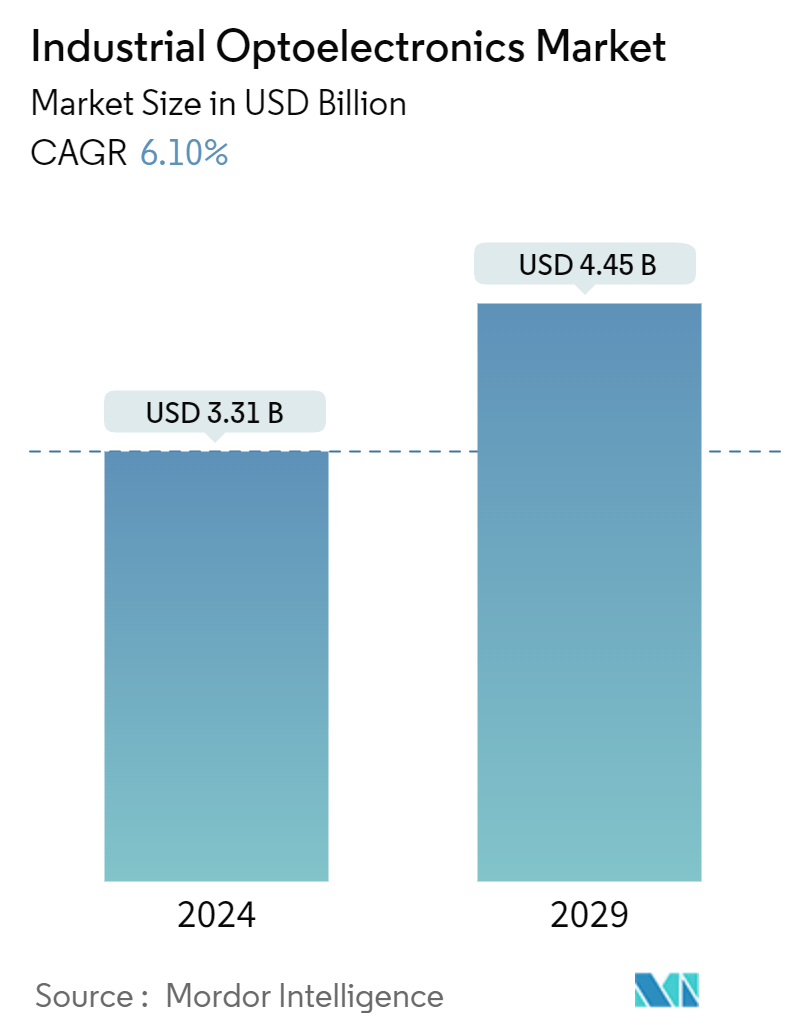
| Study Period | 2019 - 2029 |
| Base Year For Estimation | 2023 |
| Market Size (2024) | USD 3.31 Billion |
| Market Size (2029) | USD 4.45 Billion |
| CAGR (2024 - 2029) | 6.10 % |
| Market Concentration | Low |
Major Players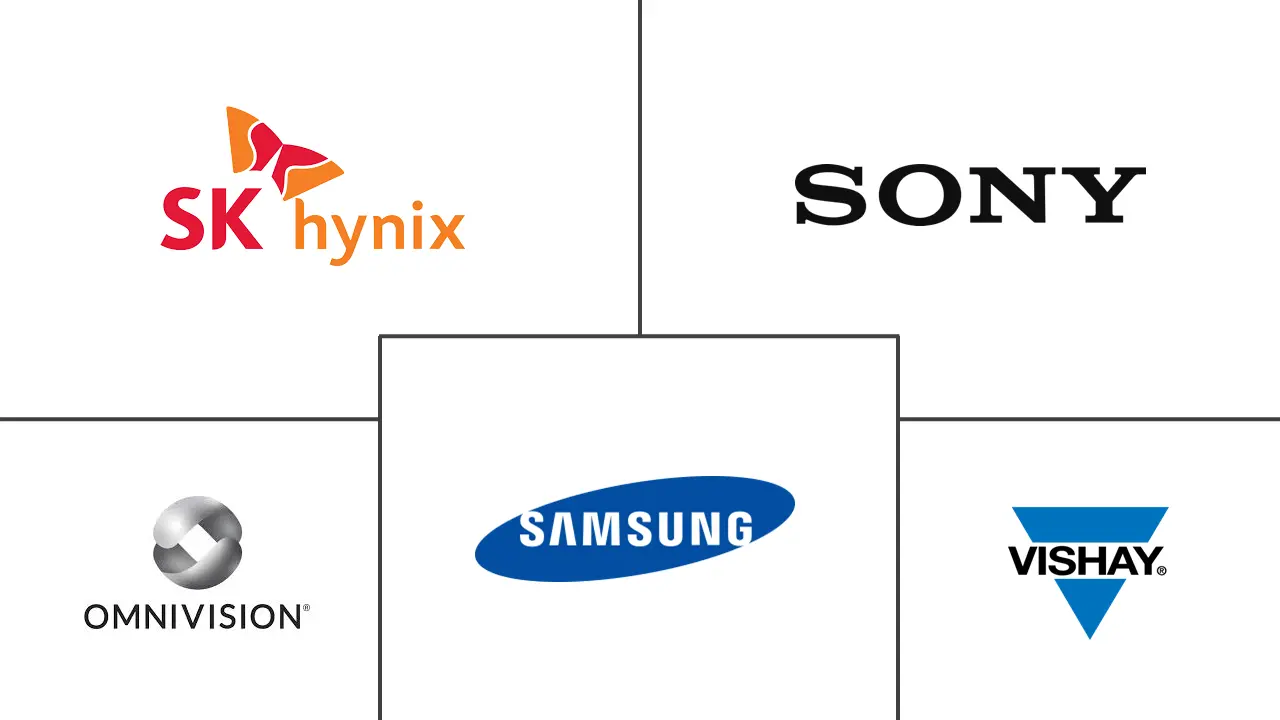
*Disclaimer: Major Players sorted in no particular order |
Industrial Optoelectronics Market Analysis
The Industrial Optoelectronics Market size is estimated at USD 3.31 billion in 2024, and is expected to reach USD 4.45 billion by 2029, growing at a CAGR of 6.10% during the forecast period (2024-2029).
- Optoelectronics, a rapidly growing technology sector, involves the utilization of electronic devices to generate, detect, and manage light. LEDs have emerged as the de facto standard in electronic device display technology, driven by consumer preferences for enhanced performance and resolution. The industrial sector is witnessing a surge in the adoption of optoelectronic components, propelled by the increasing consumption of advanced manufacturing and fabrication technologies.
- LiDAR technology is widely adopted in industrial sector automation in applications such as AGVs, robot vacuums, and AVs and depends on laser diodes for accurate distance measurements and spatial recognition. To meet the need for improved performance, ROHM has developed patented technology that narrows the emission width of laser diodes, enhancing detection range and accuracy. In December 2023, ROHM introduced a 120 W laser diode to address the growing market demand for higher output. The RLD90QZW8 laser diode is designed for industrial and consumer applications, focusing on distance measurement and spatial recognition.
- The expansion of factory automation and the increasing implementation of smart factories have significantly driven the demand for automated production lines. These lines incorporate numerous robots, monitoring systems, and communication modules, each containing multiple processors and optocouplers, laser diodes that utilize optoelectronics devices. Robots, armed with image sensors, excel at tasks like component identification, precise dimension measurement, guiding machines or fellow robots in assembly, and executing pick-and-place operations.
- The growing demand for the installation of industrial robots fuels market growth. For instance, in 2023, the International Federation of Robotics reported a 12% increase in total industrial robot installations, with figures hitting 44,303 units. This surge was primarily driven by heightened automation investments by US manufacturers. Noteworthy installations in the US market included metal and machinery, which saw 4,123 units installed, marking a 6% increase, and the plastic and chemical sector, which installed 3,213 units, reflecting a 5% uptick.
- Supply chain disruptions restrict semiconductor devices' mass production. Further, the increasing inflation and interest rates have reduced consumer purchasing power, which is expected to reduce the demand for industrial robots and hamper market growth.
- Geopolitical conflicts, such as the invasion of Ukraine by Russia, have further disrupted the semiconductor supply chain. For example, the production of neon, a critical component for chip manufacturing, was affected when Ukraine’s leading neon suppliers halted operations. Trade disputes, export controls, and regulatory changes have disrupted the flow of raw materials and components, further exacerbating the optoelectronics shortage.
Industrial Optoelectronics Market Trends
Image Sensors are Expected to Hold Major Market Share
- CMOS image sensors are increasingly becoming the preferred technology for the most sophisticated industrial cameras. CMOS technology significantly streamlines the intricacies of industrial camera production. This advancement enables the smoother development of compact cameras, such as smart cameras, making them increasingly adaptable across diverse industrial settings.
- Machine vision inspection systems have rapidly evolved into a pivotal component of both manufacturing and logistics. The ability of machine vision systems to enhance flexibility and automation has driven their increasing adoption.
- For instance, in July 2024, OmniVision unveiled two cutting-edge CMOS global shutter (GS) image sensors tailored for machine vision applications. In a strategic move, OmniVision introduced a dedicated Machine Vision Unit aimed at spearheading innovative solutions across sectors like industrial automation, robotics, logistics, barcode scanners, and intelligent transportation systems (ITS).
- Further underlining its commitment, OmniVision launched the OG09A10 CMOS GS sensor, marking its debut in the large-format GS sensor arena, specifically designed for factory automation and ITS applications. Boasting a large-pixel, 3.45 µm backside-illuminated (BSI) stacked global shutter, this sensor stands out with its low readout noise and high quantum efficiency (QE), ensuring exceptional image quality. These features position it as an ideal choice for machine vision applications, especially those demanding clear imaging of high-speed moving objects.
- Image sensors, in the rapidly evolving landscape of industrial imaging, robotics, and autonomous platforms, are pivotal in revolutionizing our global interaction with visual data. Despite their modest size, these devices are instrumental in converting visual data into digital formats, significantly influencing a diverse range of industries worldwide.
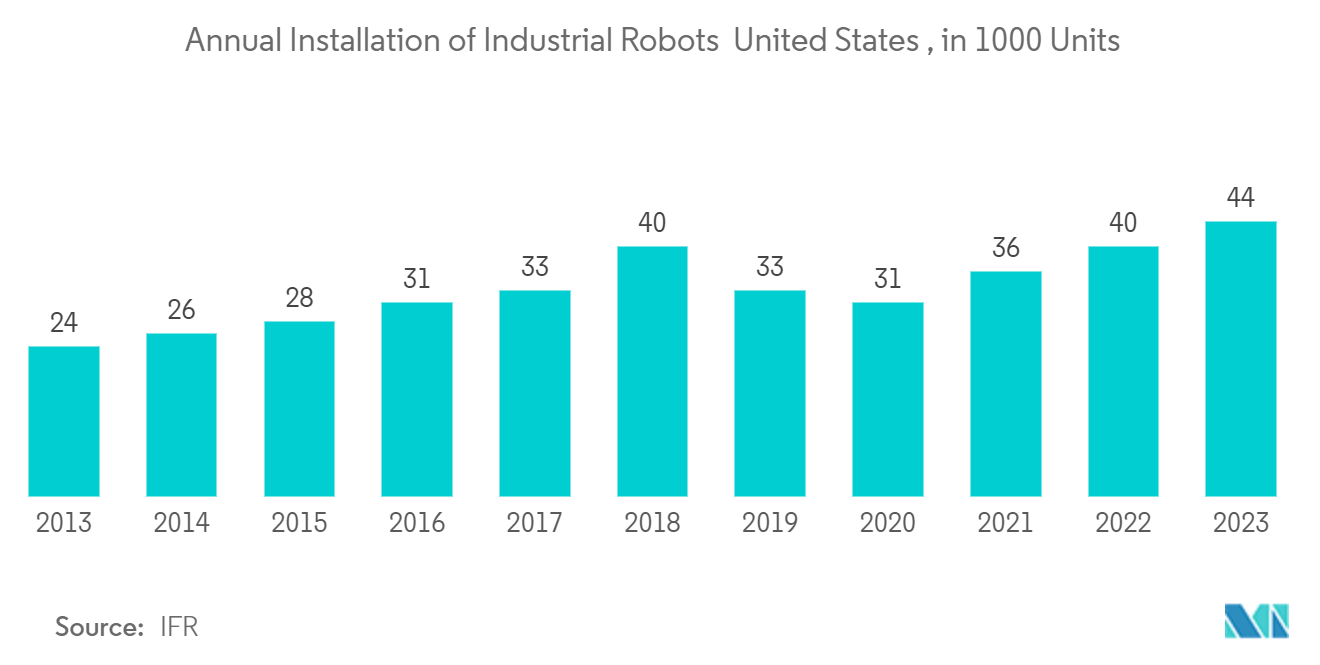
China is Expected to Witness a High Market Growth Rate
- China is expected to grow at the highest rate. The Industrial Internet of Things (IIoT) is a crucial element of Industry 4.0, encompassing the expansion and utilization of IoT in various industrial sectors and applications in China. For instance, in IIoT, sensors are widely used in different industries to monitor equipment, assets, systems, and overall performance.
- Increased industrial production across various countries, among others, drives market growth. For instance, industrial firms in China saw a notable uptick in profits at the start of 2024. As reported by the National Bureau of Statistics, industrial firms witnessed a 10.2% profit surge in January and February, marking a stark contrast to the 2.3% profit dip experienced throughout 2023.
- Furthermore, China is leading the global manufacturing industry and creating significant market demand. More and more manufacturers in China are adopting Industry 4.0 solutions to improve efficiency, driving further market growth. According to the National Bureau of Statistics of China, the industrial sector contributed approximately 31.7% to China's GDP in 2023.
- China's manufacturing sector is quickly moving toward Industry 4.0, with the country being a key player in the digital revolution. China focuses on innovation and boosting competitiveness by leveraging its strong industrial base and technological knowledge. Under initiatives like "Made in China 2025," the Chinese government aims to bolster the nation's manufacturing prowess and foster high-tech industries. In the coming years, such government initiatives are poised to drive market demand.
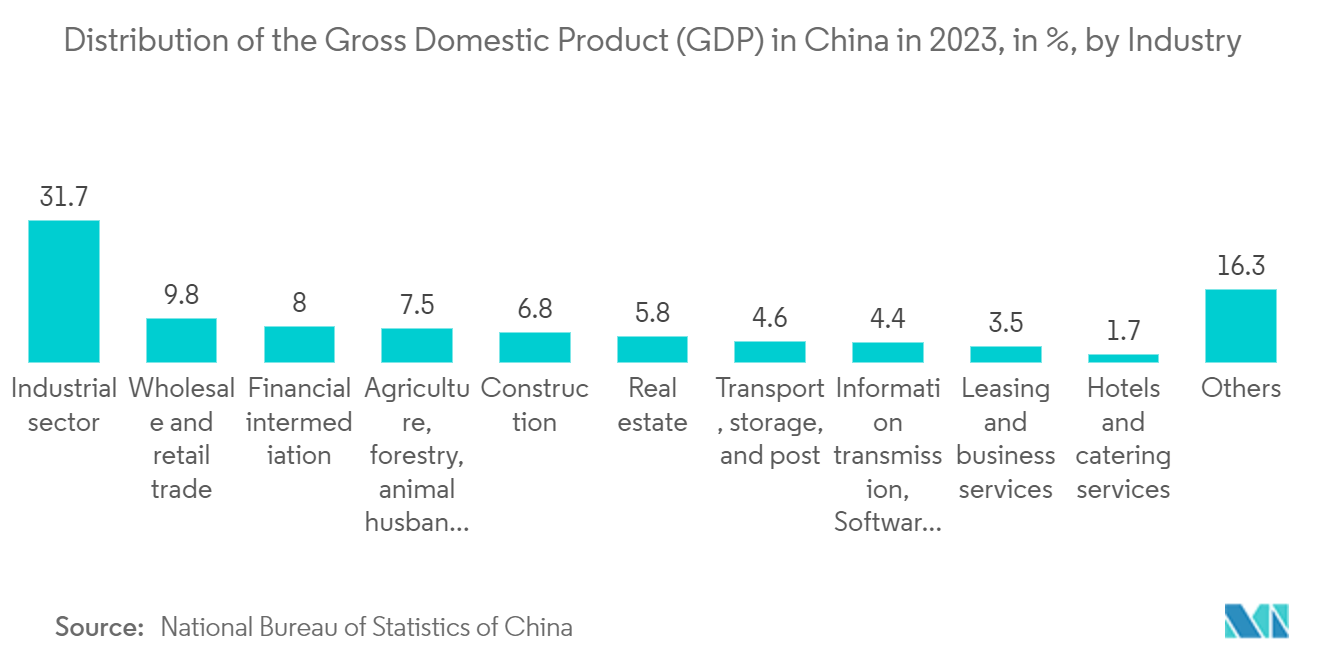
Industrial Optoelectronics Industry Overview
The industrial optoelectronics market is fragmented and features key players like Vishay Intertechnology Inc., Omnivision Technologies Inc., Samsung Electronics, SK Hynix Inc., and Sony Corporation. Market participants strategically leverage partnerships and acquisitions to bolster their product portfolios and establish a sustainable competitive edge.
- In December 2023, STMicroelectronics unveiled a cutting-edge global-shutter image sensor, emphasizing high resolution, compact design, and low power consumption. This sensor is tailored for diverse applications, spanning AR/VR, robotics (both personal and industrial), drones, biometrics, barcodes, and gestures, as well as embedded vision and scene recognition. Catering to a broad electronics clientele, STMicroelectronics is bolstering intelligent computer vision through its innovative global shutter image sensor. Notably, the global shutter technology excels in capturing clear images, especially in scenarios involving motion or near-infrared lighting.
- In November 2023, Sony Semiconductor Solutions Corporation (SSS) unveiled plans for the IMX992 short-wavelength infrared (SWIR) image sensor, designed specifically for industrial applications. Boasting a notable industry-first, this sensor features an impressive 5.32 effective megapixels, setting a new standard. Leveraging SSS's innovative Cu-Cu connection technology, the IMX992 achieves a record-breaking pixel size of 3.45 μm, the smallest in the SWIR sensor segment. Its pixel structure is meticulously crafted for optimal light capture, ensuring exceptional imaging quality over a wide spectrum, spanning from visible light to the invisible short-wavelength infrared regions (wavelength: 0.4 to 1.7 μm).
Industrial Optoelectronics Market Leaders
-
Sony Corporation
-
Vishay Intertechnology Inc.
-
Omnivision Technologies Inc.
-
Samsung Electronics
-
SK Hynix Inc.
*Disclaimer: Major Players sorted in no particular order
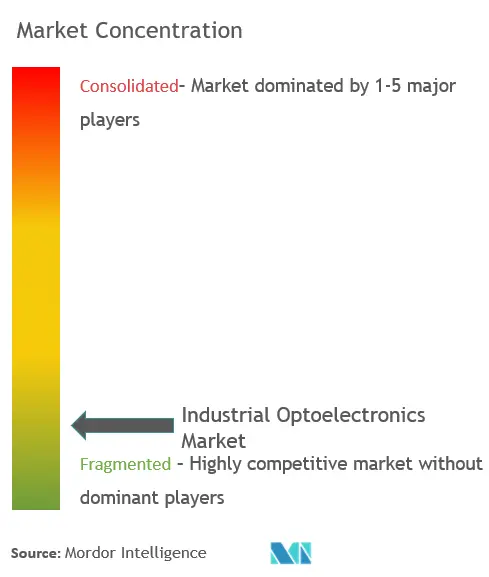
Industrial Optoelectronics Market News
- May 2024: Vishay Intertechnology Inc. unveiled the VOIH72A, a high-speed optocoupler boasting a 25 MBd speed. Tailored for industrial settings, this optocoupler stands out with a CMOS logic digital input and output interface, ensuring seamless integration into digital systems. Noteworthy features include a remarkably low 6 ns maximum pulse width distortion, a modest 2 mA supply current, and a broad operational voltage range from 2.7 V to 5.5 V, extending up to +110 °C.
- April 2024: OmniVision unveiled its latest innovation: the OG09A10 CMOS global shutter (GS) sensor. This marks the company's debut in the large-format GS realm, specifically tailored for factory automation and intelligent transportation systems (ITS). Boasting a large-pixel design, the sensor features a 3.45 µm backside-illuminated (BSI) stacked global shutter. Noteworthy for its minimal readout noise and leading quantum efficiency (QE) in its segment, the sensor excels in delivering top-tier image quality. This makes it a prime choice for machine vision applications, especially those demanding crystal-clear images of swiftly moving subjects.
Industrial Optoelectronics Market Report - Table of Contents
1. INTRODUCTION
1.1 Study Assumption and Market Definition
1.2 Scope of the Study
2. RESEARCH METHODOLOGY
3. EXECUTIVE SUMMARY
4. MARKET INSIGHTS
4.1 Market Overview
4.2 Industry Value Chain Analysis
4.3 Industry Attractiveness - Porter's Five Forces Analysis
4.3.1 Threat of New Entrants
4.3.2 Bargaining Power of Buyers/Consumers
4.3.3 Bargaining Power of Suppliers
4.3.4 Threat of Substitute Products
4.3.5 Intensity of Competitive Rivalry
4.4 Impact of COVID-19 Aftereffects and Other Macroeconomic Factors on the Market
5. MARKET DYNAMICS
5.1 Market Drivers
5.1.1 Technology Advancements, and AI Developments will Drive the Growth
5.1.2 The Continued Rise of Smart Factories
5.2 Market Restraints
5.2.1 High Manufacturing and Fabricating Costs
5.2.2 Challenges With Energy Loss and Heating of Optoelectronic Devices
6. MARKET SEGMENTATION
6.1 By Device Type
6.1.1 LED
6.1.2 Laser Diode
6.1.3 Image Sensors
6.1.4 Optocouplers
6.1.5 Photovoltaic cells
6.1.6 Other Device Types
6.2 By Geography***
6.2.1 United States
6.2.2 Europe
6.2.3 Japan
6.2.4 China
6.2.5 South Korea
6.2.6 Taiwan
7. COMPETITIVE LANDSCAPE
7.1 Company Profiles*
7.1.1 SK Hynix Inc.
7.1.2 Panasonic Corporation
7.1.3 Samsung Electronics
7.1.4 Omnivision Technologies Inc.
7.1.5 Sony Corporation
7.1.6 Ams Osram AG
7.1.7 Signify Holding
7.1.8 Vishay Intertechnology Inc.
7.1.9 Texas Instruments Inc.
7.1.10 LITE-ON Technology Corporation
7.1.11 Rohm Company Limited
7.1.12 Mitsubishi Electric Corporation
7.1.13 Broadcom Inc.
7.1.14 Sharp Corporation
8. MARKET OPPORTUNITIES AND FUTURE TRENDS
Industrial Optoelectronics Industry Segmentation
Optoelectronic devices are electronic devices and systems that involve the study, detection, and control of light. They are considered a sub-field of photonics and are used to convert electrical energy into light or vice versa.
The study tracks the revenue accrued through the sale of industrial optoelectronics by various players worldwide. The study also tracks the key market parameters, underlying growth influencers, and major vendors operating in the industry, which supports the market estimations and growth rates over the forecast period. The study further analyses the overall impact of COVID-19 aftereffects and other macroeconomic factors on the market.
The industrial optoelectronics market is segmented by device type (LED, laser diode, image sensors, optocouplers, photovoltaic cells, and other device types) and geography (United States, Europe, China, Japan, Korea, Taiwan, and Rest of the World). The market sizes and forecasts are provided in terms of value (USD) for all the above segments.
| By Device Type | |
| LED | |
| Laser Diode | |
| Image Sensors | |
| Optocouplers | |
| Photovoltaic cells | |
| Other Device Types |
| By Geography*** | |
| United States | |
| Europe | |
| Japan | |
| China | |
| South Korea | |
| Taiwan |
Industrial Optoelectronics Market Research FAQs
How big is the Industrial Optoelectronics Market?
The Industrial Optoelectronics Market size is expected to reach USD 3.31 billion in 2024 and grow at a CAGR of 6.10% to reach USD 4.45 billion by 2029.
What is the current Industrial Optoelectronics Market size?
In 2024, the Industrial Optoelectronics Market size is expected to reach USD 3.31 billion.
Who are the key players in Industrial Optoelectronics Market?
Sony Corporation, Vishay Intertechnology Inc., Omnivision Technologies Inc., Samsung Electronics and SK Hynix Inc. are the major companies operating in the Industrial Optoelectronics Market.
What years does this Industrial Optoelectronics Market cover, and what was the market size in 2023?
In 2023, the Industrial Optoelectronics Market size was estimated at USD 3.11 billion. The report covers the Industrial Optoelectronics Market historical market size for years: 2019, 2020, 2021, 2022 and 2023. The report also forecasts the Industrial Optoelectronics Market size for years: 2024, 2025, 2026, 2027, 2028 and 2029.
Industrial Optoelectronics Industry Report
Statistics for the 2024 Industrial Optoelectronics market share, size and revenue growth rate, created by Mordor Intelligence™ Industry Reports. Industrial Optoelectronics analysis includes a market forecast outlook for 2024 to 2029 and historical overview. Get a sample of this industry analysis as a free report PDF download.



